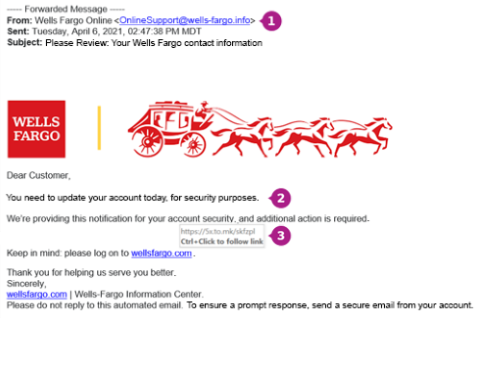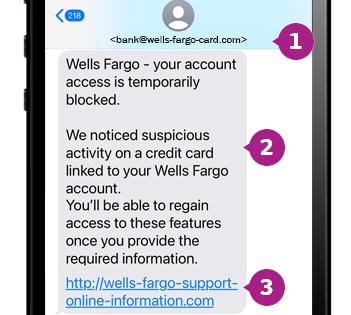
Phishing scams can come from fraudsters via text, email, or a phone call and often use an urgent tone to push you to act quickly.
They may pose as someone you know or as a legitimate organization to ask for an immediate payment or sensitive information.
Remember that you should never share your PIN, online banking password, or one-time access codes with anyone. Wells Fargo will never ask for this information.
Here are five steps to help spot, avoid, and report phishing attempts.
Phishing messages can skillfully imitate your bank, a government agency, or another organization you recognize or trust.
Here are two phishing examples that imitate Wells Fargo communications.

Phishing email example
When in doubt, sign on to Wells Fargo Online ® or contact us directly by calling the number on the back of your card.

Text phishing example
When in doubt, sign on to Wells Fargo Online ® or contact us directly by calling the number on the back of your card.
Phishing attempts often arrive as an urgent request.
Be suspicious of messages that announce a “problem” with your account or ask you to immediately log in to unlock your account, verify a transaction, make an online payment, or reverse a payment.
When asked to “act immediately,” do the opposite. Go slow and resist the urge to respond right away.
Phishing attempts can be sophisticated and may even spoof (or imitate) caller ID making the call look legitimate.
Don’t assume a communication can be trusted simply because it appears or sounds legitimate.
Contact the organization directly by going to their website.
To verify communications that appear to be from Wells Fargo, sign on using the Wells Fargo Mobile ® app or type “wellsfargo.com” into a new browser tab to access Wells Fargo Online ® directly.
When you receive an urgent request that doesn’t seem right, hang up or close the message. You aren’t being rude — you are being wise.
Actions to avoid:
Wells Fargo offers additional security options for signing on to your account. Learn more about our enhanced security tools and authentication options.
Be sure to use Wells Fargo Online ® to regularly monitor your account for suspicious activity. You can also turn on additional alerts to be notified of transactions and withdrawals.
If you’ve fallen victim to phishing
Call us immediately at 1-866-867-5568 if you clicked a link, opened an attachment, sent a payment, or provided personal or financial information in response to a suspicious message.
If you’ve spotted a phishing attempt
If you see a suspicious message mentioning Wells Fargo but didn’t click on the link or open any attachments, email the message to us at reportphish@wellsfargo.com and then delete it. You will receive an automated response.
If the suspicious message is unrelated to Wells Fargo, consider contacting that organization directly to report the incident.
When to report fraud
If you suspect you were the victim of fraud related to your Wells Fargo account, contact us immediately.
Learn more about how you can proactively help to protect your Wells Fargo account.
Availability may be affected by your mobile carrier's coverage area. Your mobile carrier's message and data rates may apply.
Sign-up may be required. Availability may be affected by your mobile carrier's coverage area. Your mobile carrier's message and data rates may apply.
Please note that due to technical reasons, some email messages forwarded to reportphish@wellsfargo.com may be rejected by our server. If this occurs, please delete the suspicious email or text message. Wells Fargo regularly works to detect fraudulent emails and websites. Thank you for taking steps to protect your personal and financial information.